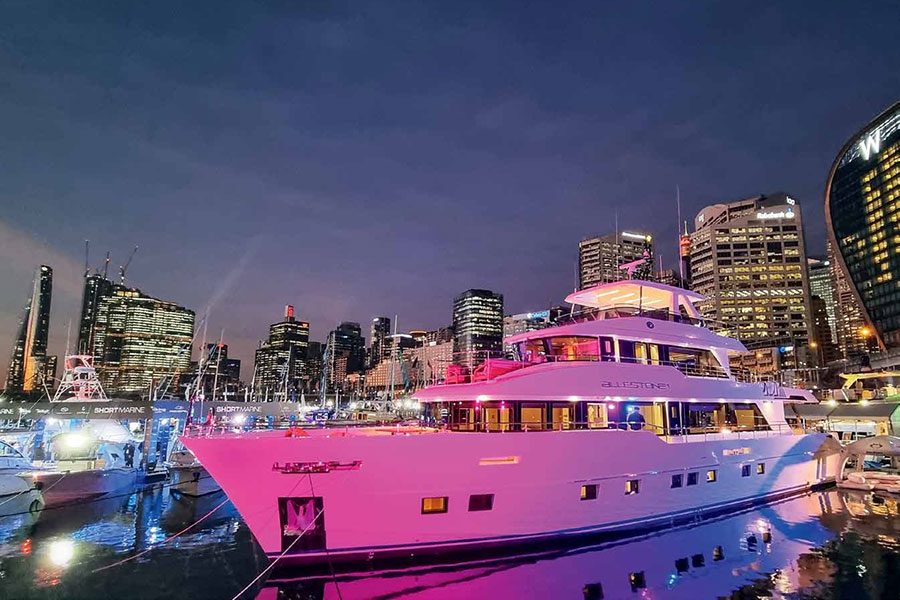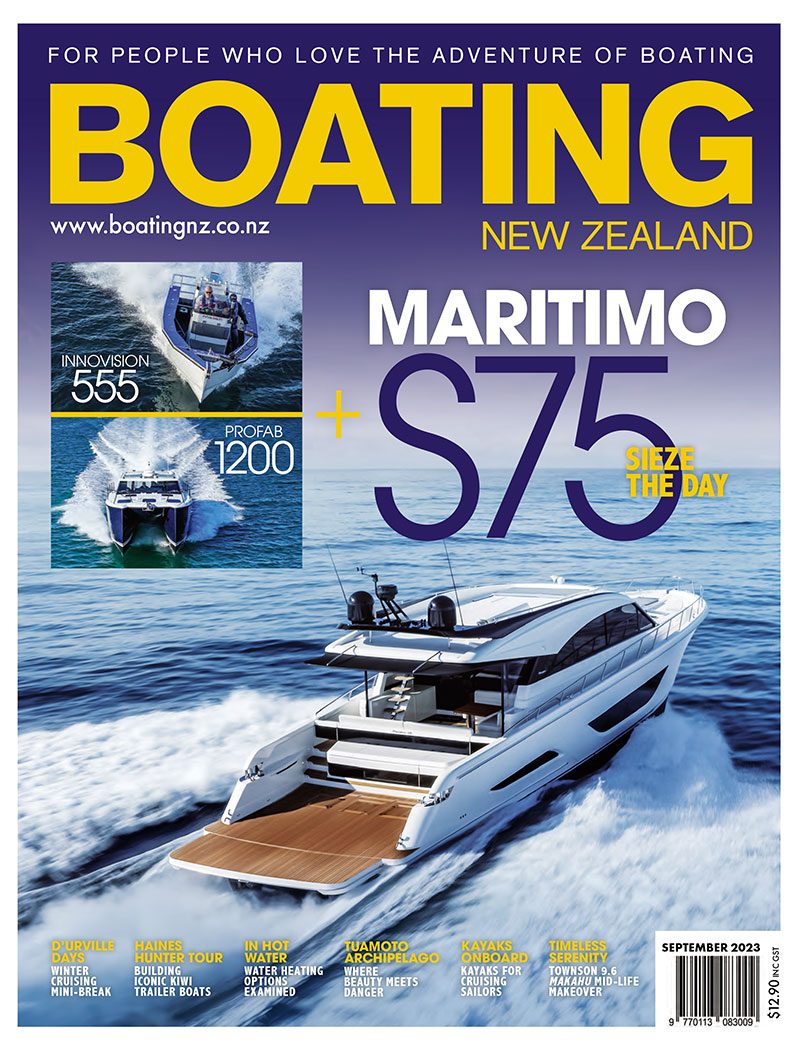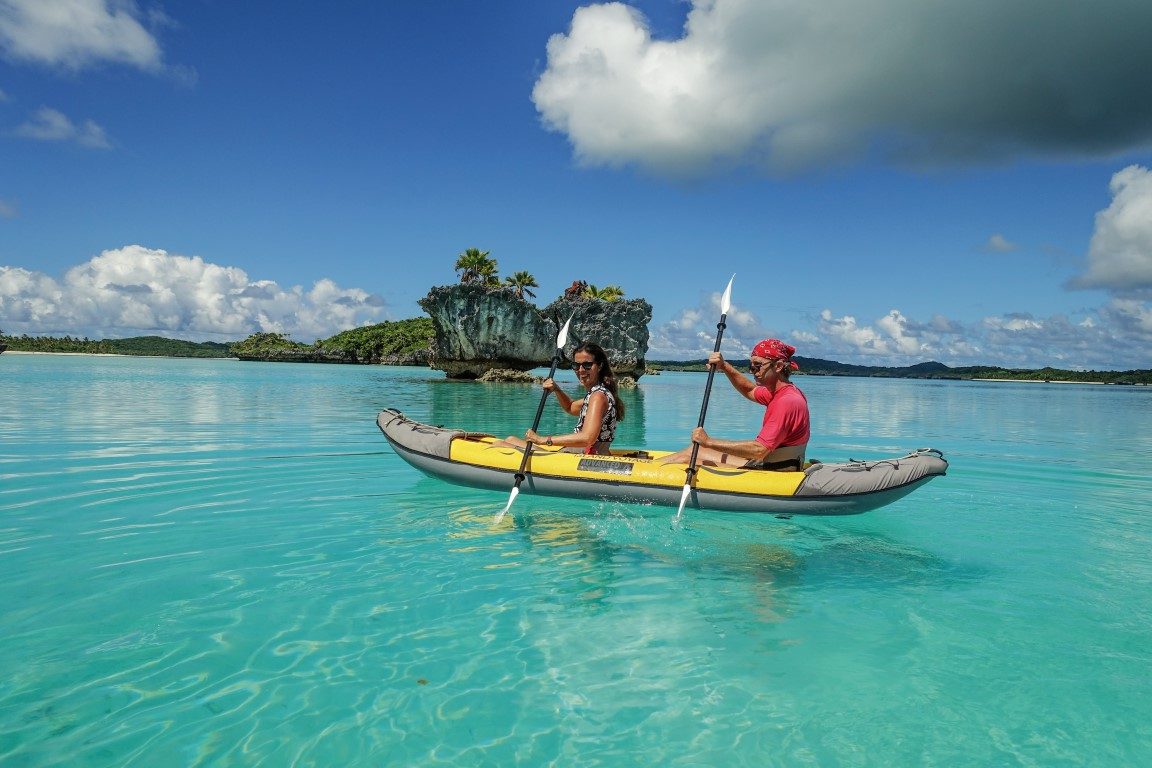Something for everyone
The Sydney International Boat Show (3-6 August) offered a bit of everything, no matter how large or small your budget, reports Kevin Green.
Ranging from Hobie sailing canoes to the show flagship vessel – the $14 million Nomad 101 – there was plenty to engage the 47,000 visitors at Sydney. Plus, an esteemed line-up of speakers such as rower Michelle Lee, who told me that doublechecking the self-righting capability of her boat probably saved her life in mid-Pacific.
The theme of sailing meant that yachts played a major part in the show, such as the Polish Viko S30 that was the most affordable (A$235,000), to premier brands such as the glamorous Beneteau Oceanis Yacht 54. Racing sailors flocked to the new Beneteau First 36 and the quality Grand Soleil LC 46.
Dayboat-weekender style of sailing craft is a new category for Sydney. This was represented by the exquisite Dutch Saffier Yachts 33 Life (A$539,000) and the very similar French Tofinou 9.7. Multihulls are major nowadays and were well represented with show flagship the Lagoon Sixty 5 offering six cabins with galley options as well. Starter models included the sporty 38foot Excess 11 and the Australian Seawind 1160 Lite, which can have diesel outboards. Offshore sailors patronised the new Catana 50 Ocean Class, with electric daggerboards.
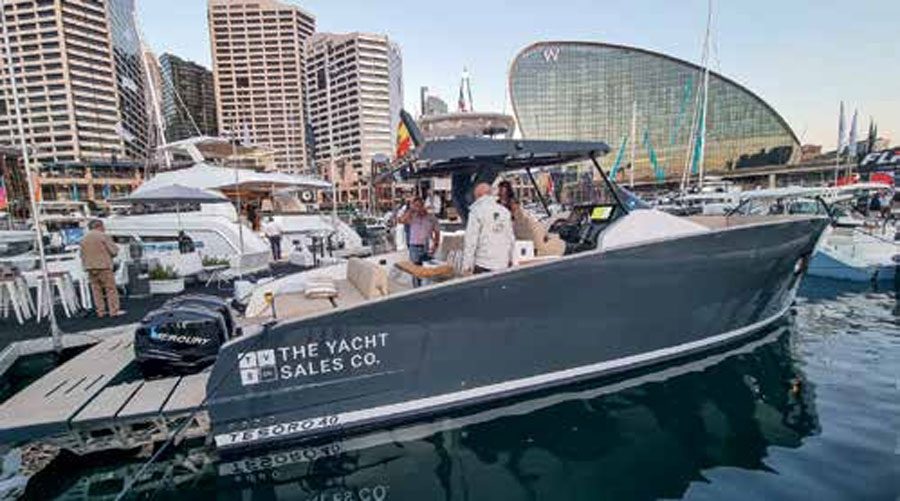
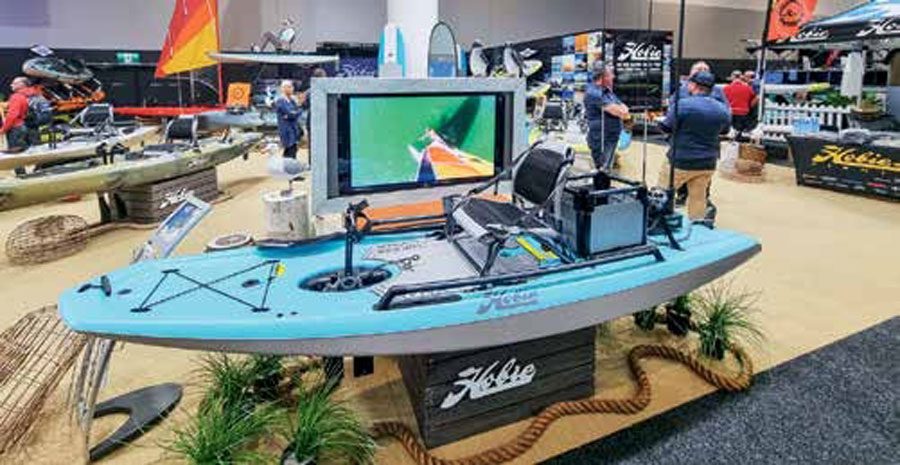
Power catamarans is a major sector, represented by the Australian-designed Iliad 53 flybridge model and many others, including the versatile Aquila Molokia 28.
Another growing category is exclusive dayboats, which double as superyacht tenders. New brands to Australia included the Spanish made Tersero T40 with tall topsides that allow four sleeping berths and full fit-out below. Competitor, the Virtue V10 T-Top has even more space on deck thanks to fold-out topsides.
Another similar brand premiering was the range of Rand electric motorboats, while traditionalists checked out the classic-looking Vicem 55, built in Turkey. In the hall, Mercury outboards had their new range of electric Avator models on display, which are ideal tender engines. Interestingly, the more compact models use an external power bank, so have a longer range. BNZ
Win or lose?
It is with mixed feelings that I contemplate recently announced plans to introduce 19 new marine protection areas inside the Hauraki Gulf Marine Park.
Not because the Gulf doesn’t need to protect and restore marine habitats and ecosystems – it does, and action on this front has been too long in coming – but because I believe recreational fishers, of which I am one, will be disproportionately penalised if the Hauraki Gulf/Tīkapa Moana Marine Protection Bill is passed as proposed.
The new protections include extensions to two existing marine reserves at Cathedral Cove and Goat Island, the creation of 12 High Protection Areas (HPAs) – no-take areas where fishing or food gathering is prohibited – and five seafloor protection areas (SPAs), where commercial and recreational fishing will be allowed provided there is no bottom contact.
In total, including Cable Zones, about 18% of the Gulf will be protected. Authorised customary fishing and harvesting of seafood will be allowed in high protection areas.
Marine protection areas will affect me personally, along with many thousands of others who love to fish and dive the waters of the Hauraki Gulf. I’m mostly a small boat fisher, restricted to inshore areas. So I’m disappointed to note that several of my favourite fishing spots will be swallowed by new HPAs. The same will doubtless be true for thousands of other recreational fishers.

Then there are the charter boats that take recreational fishers further out into the Gulf to places like the Mokohinau Islands, Aldermen Islands, Cape Jackson and Channel Island – even Little Barrier Island – all of which fall wholly or partly inside HPAs. What will become of those businesses?
But I’m willing to take one for the team should the proposed protections give us a healthier, more diverse marine environment with more fish in the water. If that happens, we all benefit.
However, I’m concerned these new protections will only increase fishing pressure on the rest of the Gulf. And that they neither properly address bigger issues like commercial fishing, including bottom trawling (which will continue inside the Marine Park) and pilchard seining (removing a main food source for fish, birds and marine mammals), nor environmental damage from sedimentation and pollution arising from land-based activities. Meaningful controls on these activities would, in my opinion, offer far more effective protection for the Gulf than squeezing out recreational fishers.
Maybe I’m being selfish, but I would far rather see commercial fishing excluded from the Marine Park, along with stricter environmental controls for land-based developments, than lose my favourite fishing spots!
There will be another opportunity for the public to provide feedback during the Select Committee process on the Bill.
The Government hopes legislation and protection will be in place by mid 2024.
John Eichelsheim
Editor


Kayak onboard!
An inflatable kayak has opened up a whole new world of exploration and fun for this year-round cruising couple Birgit Hakl and Christian Feldbauer.
Cruising in Fiji this year we anchored in the beautiful Bay of Islands on Vanua Balavu in the Lau Group, surrounded by picturesque mushroom-shaped limestone islands.
On the day after we arrived we woke to a perfectly calm morning with the fantastic landscape mirrored on glassy calm seas. We took Pitufa on a scenic tour through the bizarrely-shaped maze, anchored in a tiny bay, went snorkelling on a nearby reef and flew our drone. We posted pictures of that perfect day on our blog and got raving comments of people wishing they were with us in that amazing setting.

What they didn’t know was that a stiff southeasterly started blowing the very next day and kept whistling for almost two weeks. The churned-up water was too murky for fun snorkelling and the drone got grounded by the gusty wind for safety reasons. We’d usually enjoy some shore activities in cool weather, but the limestone islands are too spiky to climb up and there are no paths through the dense vegetation. There’s always a long to-do list of boat projects for windy and rainy days, so we dived into maintenance. But after a few days without getting out we were suffering a bad case of cabin fever. Just then a Kiwi family paddled by in their kayak and we realised what an important gadget we were missing on Pitufa!
Back in the land of internet we immediately ordered a kayak. Ella our Advanced Elements kayak arrived soon after and, so far, we haven’t found a single disadvantage to having her as a new crew member. It’s pure joy to move about in nature, propelled by our own muscle power and feeling the sun, wind and spray on our faces while paddling to a sandy beach or pristine reef!
More fitness for boaters
As year-round cruisers, we don’t do enough for our fitness. On passage, bursts of activity (some quick winching when reefing) are followed by long phases of inactivity, just holding on in bad weather and lazing around in calm seas. Everything on board is located within reach or at least within a few metres, so there aren’t many steps to count (even if we wore a watch with a step-counting app).
Circulatory training is vital for both health and well-being, but it’s hard to find regular opportunities for that. Some ambitious sailors can be seen doing yoga on deck in the morning, while even sportier ones go jogging ashore, and of course there are occasional work-out bursts for kite-surfers when a stiff breeze is blowing. But most of us don’t move enough, apart from going snorkelling (where you hardly ever manage to work up a sweat) or taking an occasional hike.

The kayak has changed that: now we get regular exercise taking it to shore or just paddling around the anchorage for fun. Of course, a SUP is also light, can be carried when necessary, and is great to paddle on a glassy-calm lagoon. But the advantage kayaks have over these wobbly devices is their sturdiness. While SUPs are only fun in calm conditions, kayaks can safely be taken out for a ride even when it’s choppy out there, so no excuse for slouching on the couch in rougher weather!
A kayak for safety and as back-up
As they have hardly any draft, kayaks can take you over shallows that dinghies cannot navigate. If it gets too shallow even for the kayak, you can always just pick it up and carry it for a stretch before paddling on. Schlepping a dinghy would be cumbersome, but a lightweight kayak poses no problem at all on such occasions.
Trying to land a dinghy in rough conditions on a rocky coast is a risky business and leaving the dink anchored out in possibly breaking waves leaves an uneasy feeling while lingering ashore. It’s much safer to take the kayak in such conditions, as we can simply carry it out of the danger zone and leave it in a safe place while we are gone.
Kayaks are also great in areas with a large tidal range. Have you ever left your dinghy tied to a tree at high tide and returned to find it high and dry? After dragging the heavy RIB over rocks and slippery mud towards the receding sea a few times, we have learned to look at the tide-table before heading ashore, but you can’t always time your shore visits according to the tide. Even with good planning, we must sometimes anchor either far out at low tide (and have to swim to the dink at high tide) or carry the dinghy back to sea later. A lightweight kayak can much more easily be carried to shore or back out to sea at low tide.

It’s also reassuring that we’d have some alternative means of transport in case some misfortune should happen to the dinghy (not, touch wood!). If the dinghy has to stay on deck for a few days to let the glue on a repair fully cure, we can still venture out with the kayak. If the dinghy gets blown away, we could at least go out and search for it. In the worst-possible scenario of a lost dinghy, the kayak would be a vital means to go ashore and get some shopping done.
Environmental considerations
Apart from some gentle splashing and an occasional curse when it won’t stay on course, a kayak glides along soundlessly. It’s a wonderfully serene way to explore a remote shoreline and we get to see much more wildlife than we would from our dinghy with its noisy outboard engine. Powered by MP (muscle power) instead of HP (horsepower), a kayak is an emission-free, pollution-free alternative to petrol or diesel power. Sailing to a destination and then kayaking when we get there allows us to be perfect eco-tourists, with a zero carbon footprint. In times of high fuel prices, using the dinghy less often also means that we are going easy on the cruising kitty by paddling instead of motoring.

Instead of buying two kayaks for the two of us, we decided to get a two-seater, and yes, manoeuvring the little boat to an agreed-upon destination can sometimes lead to arguments about tactics, techniques, and navigational options, but we have always made it there and – more importantly – back home again by working together. We can therefore recommend paddling a double kayak as one way for couples to improve communication and cooperation!
We opted for an inflatable version, because Pitufa’s decks are cluttered enough without another gadget tied to the railing. Our two-person Advanced Elements kayak weighs only 16kg and – once deflated – fits into a carrier bag easily stored below deck on passages.
D'Urville Days
“We need a few days away!” I said to Tom. After 10 successive days of rain and gloom, a high moved in, the sun came out and cool southerlies brought snow to the ranges around Tasman Bay. We headed out of The Cut from Nelson’s Haven, aboard our Craddock 36 Zest on Thursday May 11, 2023. Story by Vicky Jackson.
The summer cruise is the long one, a month away for many, or in our case last summer, three months away aboard Zest – a circumnavigation of the North Island. But from our home base in Nelson, short cruises are also very possible. Late autumn and winter cruising can be rewarding, made even better when you have a heater onboard! And the anchorages are not crowded.
Our favourite local cruising area is north to D’Urville Island Rangitoto ki te Tonga. There are no extensive sandy beaches as in the Abel Tasman National Park, but neither are there water-taxis and trampers, nor very many boats.
As we motored down Nelson Harbour, the panoramic view was of snow – a lot of snow – covering the mountain tops on the west coast and even on the Bryant Ranges up behind Richmond. It was cool, perhaps cold, with the white snow and blue sky providing a picturesque backdrop over the Boulder Bank and across Tasman Bay. A light southwest wind gave us a broad reach as we motor-sailed north.

Greville Harbour, halfway up the west coast of D’Urville Island, has an inner and outer part. We hoped that we could anchor in one of the outer bays, to the southeast, so long as the northerly swell was not going to give us a rolly night. We were fine – it was a gentle, almost soporific swell, Zest was like a baby being rocked in a crib.
The inner part, into Mill Arm, provides more bays and two club moorings but a boat must negotiate the narrow pass through the stony bank, with its fast-flowing tidal current. There are two markers, but it pays to read the text in the New Zealand Cruising Guide Central Area, as one cannot approach the gap and markers square-on. Our evening was quiet, near three homesteads in Owhai Bay, with steep swards of green behind us.
The heater went on in the early evening in preparation for the drop in temperature. But we turn it off at night. The next morning required a quick exit from the sleeping bags to don four merino layers; the saloon was a cool 9°C.
By 0930 we were heading out of Greville Harbour. The course northeast passes majestic cliffs, soaring almost vertically from the water. We looked ahead, almost due north and saw something else: a conical island appearing as a knuckle above the horizon, almost melting into the blue-grey of the sea. Though it looked like an island, we questioned our knowledge of New Zealand geography; the only feature in that position was a high mountain, Taranaki. The peak is 2,518m high and we could see its top from 90 nautical miles away.

Like Hardy himself, Port Hardy’s place names pay homage to Lord Nelson: Nile Head, Nelson’s Monument, Victory Island, Trafalgar Point. There are rocky headlands, islands and islets, with a rip just offshore from Nile Head powered by the mixing tides. The South Arm of Port Hardy is an inlet that cuts 3.3km into hills at the top of D’Urville. There are a few farms and maybe four houses, but much of the area is native bush with thick foliage, spreading up from the water’s edge.
To the west and east there are small bays giving a choice of anchorages. The last bay on the west side, Philante, is our favourite. It is very sheltered, with three mooring buoys, for Tasman Bay Cruising Club (TBCC), Pelorus/Waikawa/Mana (PWM) Clubs and 40°S Club.
Swinging to the blue TBCC mooring, we were on our own, except for a small inflatable on the PWM mooring. The bay oozed peace and calm, which was reinforced by the joyous bird song ringing out from the bush. We always find this a magical place.
For those who know it, this bay is one boats frequently return to. We have got to know Chris and Sarah, although we only ever meet them once a year – Sunstone and now Zest meet up with Flying Fox on the 25th or 26th of December. Well, we have done so for more than five years.
The launch that returned to its dinghy, was also one we had met in this same bay over Christmas in 2020, Southern Cross, from Mana. Her crew love fishing and the day had been productive. We were generously offered two snapper – two lovely meals for us. They were after crays the next day.

And then a blue steel yacht motored slowly in and set her anchor in the more northern corner of Philante. It did not take long to identify Taranui with Brian and Hilary on board. We had not seen them here before, but we had shared anchorages in Vava’u, Tonga, in Northland, and closer to home in Torrent Bay, Abel Tasman National Park. The next day, Sunday, we caught up over coffee and freshly-cooked muffins, sharing tales of offshore cruising and tramping.
With just a week’s cruise, we stayed on the west coast. However, the eastern side of D’Urville Island provides some sheltered anchorages, especially in winds from the westerly quarter. Catherine Cove to the southeast is a good spot to finish or begin a transit of French Pass/Te Aumiti.
This piece of water has a reputation and must be respected. It is not a place to be with strong winds. In light to moderate conditions, working the tide and carefully checking the situation, the narrow gap can be navigated by a boat with a strong and reliable engine. There is one proviso: the stated times for high and low tide and the direction of flow are ‘created’ by humans. In real life, tidal flows, heights, and streams are influenced and changed by pressure, rainfall, and winds even 50 miles away. It often pays to be a little early and stand off to watch and see the flow yourself.

There is also shelter from southwest to northwest winds in Whareatea Bay and between the Rangitoto Islands. Here the fishing is particularly good. While French Pass has a reputation, we are also very cautious when using Stephens Passage, passing between Cape Stephens and Saddle Rocks in the far north. The water flows strongly in this gut and we have often encountered very confused seas with white water, even in benign conditions. The reward is spectacular scenery, rocky islands, some with arches – notably The Sisters – and craggy headlands.
Our third west coast anchorage is another favourite and one we have used frequently. It is only 52km from Nelson. Opotiki is at the northwest corner of the larger Manuhakapakapa Bay. It is very pretty, in a different way from Port Hardy. The steep, pastured hillsides are grazing land for sheep and cattle with just one house at the head of the bay surrounded by conifers just above the pebble beach. The anchorage is easy with plenty of space, but there can be a downside. We have experienced very strong down-drafts, usually when the wind is fresh from the northwest, storming down the hillsides and even creating williwaws at times that spiral over the bay. This makes for a less than relaxing time at anchor; but we have proved that the muddy bottom is very secure. At other times, as on this occasion, the bay is calm and settled and we are often the only vessel.
Opotiki does provide more opportunities for cruisers to stretch their legs. I took a beach walk on the first afternoon over the many coloured pebbles, some of them flat enough to skim over the water. The next day I took a more challenging walk up the steep hillside and ridges to the west. At the top big views open up to the anchorage, down the steep cliffs to the west with bright blue water in the shallows, across Tasman Bay to Separation Point, and along the coast south to Pepin Island.

I was breathing hard at the top, taking in the beauty when I noticed a closer sight – a New Zealand falcon/karearea, showing his bright-yellow legs, with talons gripping the rock he was balanced on. We eyed each other intently. His yellow eye-liner was bright, matching the yellow on his legs and the inside of his black, sharp, hooked beak.
I stood still and watched. Then I dropped down and prepared my camera. I slowly moved forward, crawling over the grass, eye to eye with the falcon – a special few minutes spent close to nature. The falcon spied some food, or so I imagined, and flew off, but I felt happy from the exercise and the encounter. I made my way slowly down the steep hillside towards the anchorage, glad that I had strapped my arthritic knee.

Our return to Nelson was cool, into a light headwind. Just about all the snow had melted, although we had felt the nights had been pretty cold. Back in our berth, we tidied up. Zest would rest in the marina for a few weeks before we decided on another local destination for the next ‘Few Days Away’.
Fishing Boats NZ goes big
Alloy boats specialist Fishing Boats NZ has opened a new showroom and ultra-modern workshop facilities at a new site in Hobsonville, one of the fastest-growing suburbs in Auckland. Fishing Boats NZ previously operated out of much smaller premises in Sunnybrae Road, Glenfield.
“After 10 years the business had simply outgrown our Glenfield premises. In fact, we outgrew them at least four years ago,” Fishing Boats NZ co-owner Andrew Carlson told Boating New Zealand. “We wanted somewhere with more space, easier boat access, and the potential to better showcase our products.”
Jointly-owned by Andrew Carlson and Rhys Sutton, Fishing Boats NZ bought a 5000m² site at 2 Inanga Street, Hobsonville in 2019, close to the motorway, rim road and Waterview tunnel. Within easy reach of the fast-growing suburbs of Whangaparaoa Peninsula, Silverdale and Orewa, “we’re still only 10 minutes’ drive from our old premises, so still close enough to our North Shore customers,” says Andrew.
Covid initially delayed development of the North Harbour site, but construction began in September 2022 and the stunning new facility opened its doors on July 24 this year.
With excellent customer parking, seven-metre-wide gates, and a massive paved outdoor yard, the new complex is purpose-built for easy access and stress-free drop-offs. It’s a huge step up in terms of size, customer appeal and ease of access from the old premises. The nearest boat ramp is only one kilometre away.
Incorporating a 1000m² showroom, a 700m² workshop and a 300m² trailer workshop, the complex can accommodate up to 40 boats undercover in its bright, new showroom. The bespoke, clean, modern workshop is home to Fishing Boat NZ’s team of eight skilled marine mechanics, plus an apprentice, as well as the trailer shop, where Fishing Boats NZ builds high quality aluminium boat trailers. There is also a full-time upholsterer – a new addition to the business.
“It’s the first time we have been able to house all the various parts of the business under one roof,” says Carlson. Fishing Boats New Zealand’s new facility has 24 trained staff.
The workshop currently looks after the servicing and repair needs of four Coastguard organisations, the Department of Conservation, the Ministry of Primary Industries, Police, and a raft of high-profile boating and fishing influencers, among others.
Equipped with MiG and Tig welding equipment, and a CNC cutting machine, the workshop can also undertake fabrication and modification work alongside its usual mechanical repairs and servicing.
The company is New Zealand’s largest Surtees Boats dealer, stocking every model in the showroom. It is also the largest Yamaha dealer in New Zealand and recently became a dealer for WaveRunner jet-skis.
Around 18 months ago Sutton and Carlson took on the Senator Boats dealership with the aim of becoming Senator Boats’ largest dealer within three years, a goal they are already well on track to meet, says Sutton.
Fishing Boats NZ
2 Inanga Street, Hobsonville, Auckland
www.fishingboats.co.nz
www.facebook.com/fishingboatsnz/

